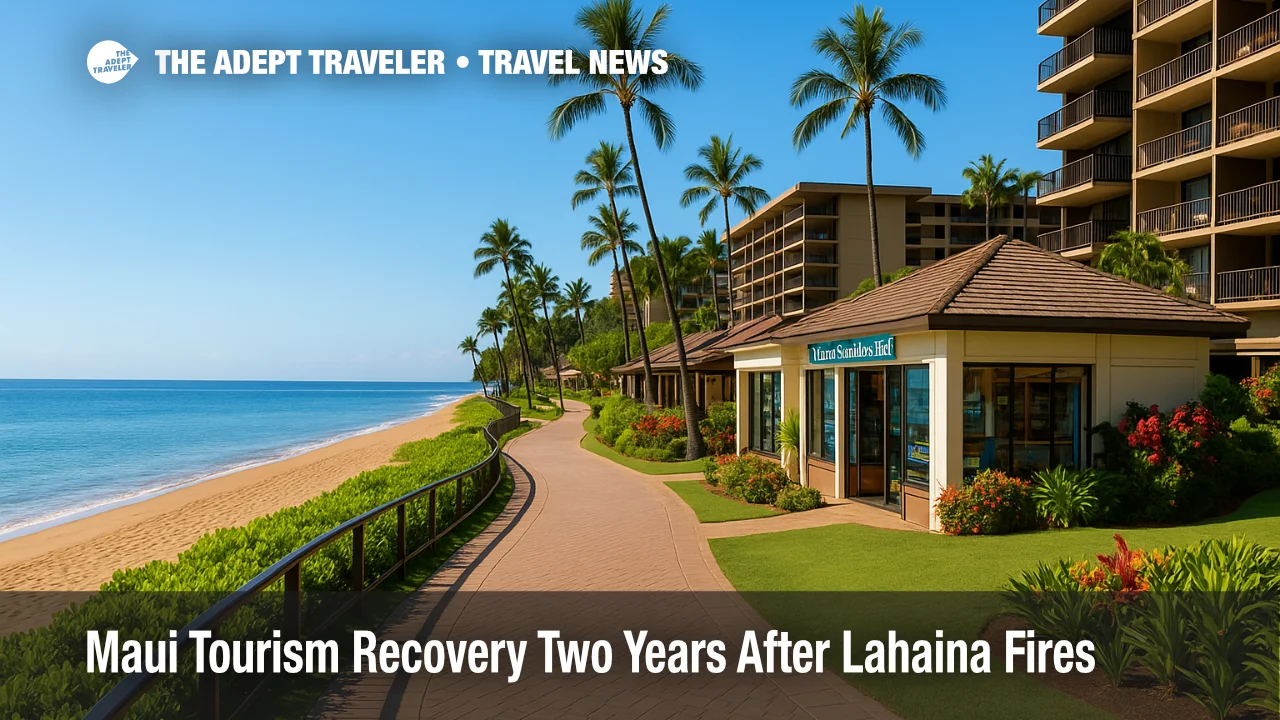Maui tourism recovery two years after Lahaina fires

Maui is sending a clear message to travelers, it is open, welcoming, and steadily rebuilding. Two years after the August 8, 2023 Lahaina wildfire, visitor spending and arrivals are rising, new and returning businesses are coming online, and community leaders continue to emphasize respectful travel rooted in mālama, care for place and people. While Lahaina town remains a sensitive recovery zone with access limits, most of the island, including resort areas in Kāʻanapali, Nāpili, Honokōwai, and Kapalua, is hosting visitors again, with air access through Kahului Airport (OGG).
Key points
- Why it matters: Tourism drives Maui's jobs and small businesses, and respectful visitors accelerate recovery.
- Travel impact: Most of Maui is open, though Lahaina has restricted areas and defined shoreline pathways.
- What's next: Reopenings continue, with more experiences returning as rebuilding advances.
- Arrivals and spending on Maui have increased compared with 2024, indicating a slow, steady rebound.
- Visitors are urged to travel with aloha and follow the Mālama Maui pledge.
Snapshot
Maui's rebound is measurable but uneven. State data show Maui welcomed 205,182 visitors in August 2025, up 2.3 percent year over year, while visitor spending reached $430.7 million, up 23.0 percent versus August 2024. For the first eight months of 2025, arrivals reached 1,709,089, up 8.3 percent from the same period in 2024, with $3.91 billion in spending, up 11.1 percent. Hotel occupancy has improved, particularly in West Maui resort areas, even as some activities and attractions adjust operations. County guidance maintains restricted access in parts of Lahaina, though limited shoreline access near the harbor reopened via marked routes. The statewide message from tourism leaders and the Maui Visitors and Convention Bureau is consistent, Maui is ready to welcome travelers who visit with respect and support local businesses.
Background
Governor Josh Green announced the phased reopening of West Maui resort communities beginning October 8, 2023, two months after the wildfire. Since then, most visitor infrastructure outside of Lahaina has returned, including major resorts, beaches, restaurants, and activities across Kāʻanapali and Kapalua. Signature attractions elsewhere on the island, such as the Maui Ocean Center and Haleakalā sunrise experiences, continue to operate with strong emphasis on stewardship. County recovery teams have gradually expanded safe access near Lahaina Harbor through designated shoreline paths while keeping closed areas off limits. The Maui Nui Strong portal and Mālama Maui County Pledge give visitors clear expectations on cultural respect, volunteer opportunities, and environmental care, aligning traveler behavior with community priorities during rebuilding.
Latest developments
Maui travel updates and where respectful tourism helps most
Recent state updates confirm Maui's trend toward recovery. August 2025 data show arrivals and spending growth on the island compared with 2024, plus an islandwide occupancy improvement from 55.2 percent in August 2024 to 62.0 percent in August 2025, with the Lahaina, Kāʻanapali, Kapalua area at 61.2 percent. On access, the County of Maui maintains that many zones in Lahaina remain restricted, but as of May 24, 2025, limited recreational shoreline access on both sides of Lahaina Harbor is permitted along marked paths, reinforcing that respectful, rule-following visits remain essential. Meanwhile, West Maui resorts are taking reservations, and marquee properties continue to refresh offerings, further signaling stability. Tourism agencies amplify a single message, come, support local businesses, learn about mālama, and follow posted guidance in and around recovery areas.
Analysis
For travelers, the data and on-the-ground protocols point to a pragmatic path. Most of Maui's visitor experiences are open, flights continue to arrive at Kahului, and accommodations and activities across West and South Maui are operating with community-driven stewardship practices. The island benefits when travelers return with empathy, spend with local businesses, and budget time for cultural learning or volunteer work. At the same time, planning should account for recovery realities. Expect clearly marked restrictions in Lahaina, respect closures, and lean on official channels for updates rather than informal social feeds. Advisors can guide clients toward areas fully open, suggest small-group or conservation-minded tours, and encourage the Mālama Maui pledge to align expectations with community needs. In short, Maui is ready, but it asks visitors to be partners in its recovery, not just spectators. That approach supports jobs today and preserves the island's cultural and environmental integrity for the long term.
Final thoughts
The story of Maui tourism recovery is one of resilience matched with responsibility. The island is welcoming visitors with open arms, and the numbers show momentum, yet patience and respect remain essential in and around Lahaina. If you are planning a trip, choose locally owned experiences, follow County guidance, learn a few phrases, and embrace mālama. Doing so helps families, small businesses, and cultural practitioners who depend on travel, and it ensures your visit contributes to a future that is stronger and more sustainable, a true win for Maui's ongoing Maui tourism recovery.
Sources
- Visitor Spending Increased in August 2025 Despite Fewer Visitor Arrivals, DBEDT
- Monthly Visitor Statistics, Hawaiʻi Tourism Authority
- Governor Josh Green declares West Maui communities to reopen on October 8, HTA
- Lahaina Town Shoreline Access, Maui Recovers, County of Maui
- Visitor information and Mālama Maui County Pledge, Maui Nui Strong
- Maui Ocean Center, hours and operations
- Maui Visitors and Convention Bureau, leadership and contact
